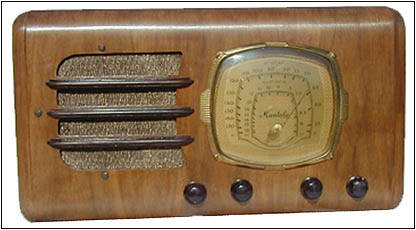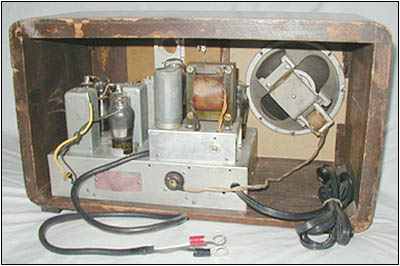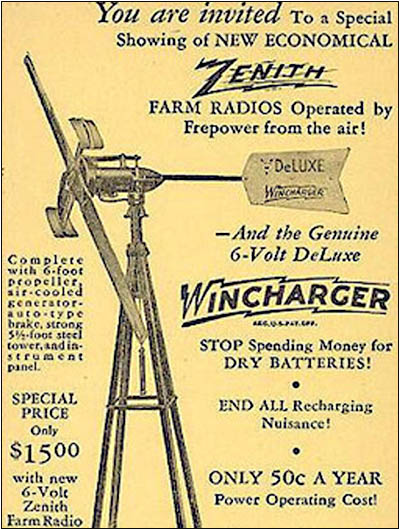Of Old Radios And Related Items--Published Monthly
"Wind-Powered Radio"
BY RON RUSSELL
Web Edition
The search for old radios is not always a successful experience. But, occasionally we hit pay dirt. Ron Russell's find sent him off in a new direction. He shares his experience and excellent research in the following article. (Editor)
The caller's name was Bill, and he'd heard that I occasionally purchased old radios. I lived in Elko, Nevada, at the time; a small town in a very remote area and, therefore, not a great resource for finding unique old radios waiting for restoration. Consequently, when Bill said that he had an antique radio he wanted to sell me, I didn't expect much more than some old junker with maybe a little salvage value.

Figure 1. The restored B.F. Goodrich Model R-422 Mantola farm radio.
Upon arrival at Bill's house, my initial suspicion seemed correct. The radio had two bands, broadcast and 6-18 Mc shortwave, but it was a brand I'd never heard of -- Mantola -- and it was in sad shape. The cabinet was a cosmetic mess, mainly due to a large decal that had been stuck next to the dial, and then scratched off later with a dull knife. Two of the four knobs were gone, and the odd-looking chassis, covered with decades of grime, was banging around loose inside the cabinet. A variety of unterminated wires protruded through access holes, and the line cord was badly frayed and wrapped in two places with friction tape.
Bill said that the radio didn't work (no big surprise there), so he wanted only $15 for it. I agreed, since the tubes alone would be worth that if they were any good.
I took the set home and stuck it in the basement, as I was busy with a big Atwater Kent console at the time. We packed up and moved to California shortly thereafter, and the box containing the Mantola became just one of many that marked time while I put my new workshop together. It finally surfaced after several months, and I decided to give it a closer look to see if it might be anything more than a source for spare parts.
What Did I Buy?
There was no model number anywhere on the set, only the "Mantola" name on the dial. The speaker was a permanent magnet type, which I thought would date the radio in the late 1940s. A check of Bunis's Collector's Guide to Antique Radios, Fourth Edition seemed to support the theory that there were no Mantolas listed earlier than 1946. But then, I pulled the two knobs off, and after removing a layer of grime, noticed that they were wood. Wooden knobs? This was no 1946 radio!
The mystery deepened when I tugged on what I thought was a metal electrolytic mounted on an unusual subchassis, and the thing easily popped out. It was a 6-volt vibrator, like one you'd find in a car radio power supply, which I thought was really strange!
By this time the Mantola had me hooked. After a thorough cleaning of the chassis, I began to trace out the circuit and soon solved the vibrator mystery: the radio had a transformer power supply that was switchable between the 110-volt AC line cord and the vibrator circuit -- the set could operate from 6 volts DC. But, why did this large tabletop set have a dual power supply, part of which belonged in a car radio? The answer came from a label inside the cabinet that revealed itself after some careful cleaning. It read: "USERS OF WINDCHARGERS -- If a windcharger is used to recharge the storage battery, DISCONNECT the windcharger from the battery when operating the RADIO. Failure to do this will reduce life of tubes."
The Answer -- B.F. Goodrich R-422
Windcharger? Storage battery? Ah, now I had it. The set was an early farm radio, intended for use in rural areas before the advent of universal electrification. "Windcharger" referred to a wind-driven generator, somewhat like a windmill, that supplied charging voltage to a wet-cell battery. A collector with more experience than mine would no doubt have seen it right off, but I'm still a little new at this game, so it hadn't been that obvious.
Anyway, I proceeded with the restoration, and was very pleased with the result. Several antique radio collectors on an Internet newsgroup that I frequent offered helpful advice. One came up with a schematic for the Mantola, revealing for the first time that it was actually a B.F. Goodrich Model R-422, dating from about 1939. Mantola had been the B.F. Goodrich brand name for the radios sold by their consumer products division. The actual manufacturer was Radio Products Company in Chicago.
The radio played very nicely after I had rewired the power supply and replaced all the fixed capacitors. Even the shortwave band performed well. After refinishing the badly scratched cabinet, as Figures 1 and 2 attest, I had a fine addition to my collection.
But I kept thinking about that "windcharger" warning label. What was it like 65 years ago, living on a farm with just a wind-driven generator to supply electricity? That question led me to further Internet exchanges with various collectors, many of whom turned out to be well-versed on early windchargers, as well as on what it was like to own and operate them on a 1930s-era farm.

Figure 2. A rear view of the Mantola. The 6-volt vibrator power supply sits on top of the right-hand corner of the radio chassis. The cable and ring-style terminals are used to make the connection to the storage battery.
Battery-powered Farm Radios
I was fascinated by what they told me. Before the power lines arrived, radios in farmhouses had to operate by battery power, and those that depended upon dry cells were prohibitively expensive to operate for long periods. The B-battery alone could cost as much as $3, a princely sum during the Great Depression. Few farmers or ranchers could afford that kind of money for only a few hours of radio time.
The invention of the vibrator power supply helped a little. Radios could now be operated from a spare car battery, and home sets with vibrator supplies began to appear. The problem with that, though, was that the battery had to be carried to town for recharging at an auto repair shop, which could take several days. Few farmers could afford a backup battery to use in the interim.
The advent of wind-driven charging systems changed all that. Beginning in the early 1930s, a number of companies began to market propeller-driven, 6-volt generators, dubbed "windchargers." When connected to a storage battery, the windcharger could provide the farm with an almost limitless source of usable power at practically no cost.
Radio manufacturers -- Zenith in particular -- were quick to see the potential for 6-volt farm sets. Zenith joined with Wincharger Corporation of Sioux City, Iowa, for a promotional scheme that proved wildly successful: Anyone purchasing a Zenith farm radio was given a coupon good for a 66 percent discount on the purchase of a wind generator system, which could be had for as little as $10 to $15. A Zenith Wincharger is shown in Figure 3.
By 1938, Wincharger had sold over 750,000 of their basic radio chargers worldwide. One of their ads proclaimed, "Operate your radio for free, and charge your neighbor's batteries at a substantial profit!" Other companies followed suit, and windchargers from Sears, Wards, Delco, and others proliferated, often displaying a collaborating radio company's logo on their rudder vanes. Examples are shown in Figure 4 (see print version).
The 32-Volt Farm System
The success of 6-volt systems led to the development of higher voltage windchargers, enabling farmers to extend power over long cable runs in order to light their barns and outbuildings. The norm became 32 volts, and an entire line of 32-volt appliances and tools followed. A well-equipped farm or ranch might boast 32-volt DC lights, toasters, coffee pots, cream separators, sheep shears, and milking machines.
The radio manufacturers kept pace, with 32-volt vibrator models, as well as simpler sets that used series filaments and only 32 volts for the plates. The Delco Models 3201 and 3202 were examples of the latter. Such sets generally had push-pull audio amplifiers in order to get adequate volume from the low plate voltage.
The heart of the windcharger system was the storage battery, which took a number of different forms. A single automotive battery or sometimes two or more connected in parallel often proved adequate, but many farms and ranches opted for large, high capacity cells in heavy glass jars, particularly for use with 32-volt systems.
Several of my Internet correspondents remembered dealing with the glass jar batteries, which were filled with sulfuric acid electrolyte and gave off hydrogen when charging. (Imagine getting that by the Consumer Products Safety Commission today!) Acid spills on the floor were common, and adequate venting, in a non-freezing environment, had to be provided to vent away the hydrogen. One 32-volt battery system is shown in Figure 5 (see print version).

Figure 3. This Zenith Wincharger ad from the 1930s extolls the benefits of the wincharger. (Courtesy of Winco Division of Dyna Technology, Inc.)
Enter the REA
The Rural Electrification Act of 1936 eventually brought an end to wind-powered farms and ranches. Power lines were extended virtually everywhere by 1950, and the windchargers had to come down or be disabled. Several power companies refused to hook up a farm with a functioning windcharger, fearing that the farmer would keep his "free" power before using and paying for theirs. Many farmers took the easy approach by simply blasting their wind machines with a high-powered rifle (to the horror of collectors many years later) in order to satisfy the power company and get the AC line connected.
Converting a farm or ranch from 32 Vdc to 110 VAC could often cause some unexpected excitement. Usually, the farmer simply removed the battery cable from the input side of his house service panel, and then the power company connected the new 110-volt AC feed to the same point. The plugs and receptacles inside the house were the same for both voltages, so there was no need to change any inside wiring or fittings. That frequently resulted in a rude surprise when those old 32-volt DC appliances were turned on!
One thing about this hobby -- you never know where a restoration project is going to take you. I had initially thought that my Mantola radio was just another run-of-the-mill tabletop set, but it turned out to be the key to a whole new area of interest. I found the subject of wind-powered farms and ranches quite fascinating as I researched this article. I also learned that there are a lot of antique windcharger collectors and restorers out there who are helping to preserve those early memories, just as we are with our venerable radios.
Thanks to the following collectors who volunteered information for this article: David Ballinger, Terry Bryant, Tom Judson, Neal Kramer, John Martin, George Munsch, Terry Sanford, Eric Wissig, and Jerry Yowell.
Photo Credits: David Ballinger, Terry Bryant, and Winco Division of Dyna Technology, Inc.
Reference:
Winco Division of Dyna Technology, Inc., Web site: www.wincharger.com. Information and graphics used by permission.
(Ronald W. Russell, 2839 Bristol Lane, Lodi, CA 95242-9661. E-mail: rruss@lodinet.com)
Ron Russell, a retired AT&T manager, works as a consulting writer for various telephone companies. Involved in commercial, military, and Amateur radio for over 40 years, he is relatively new to the antique radio hobby. His first encounter was with a Philco 42-PT-96 in sorry condition in an antique shop in 1993. His attempt to get it working was the beginning of his modest collection, several of which he has bought and sold through A.R.C.
| [Free Sample] [Books, etc., For Sale] [Subscribe to A.R.C./Renew] [Classified Ads] [Auction Prices] [Event Calendar] [Links] [Home] [Issue Archives] [Book Reviews] [Subscription Information] [A.R.C. FAQ] URL = http://www.antiqueradio.com/Mar02_Russell_Windradio.html Copyright © 1996-2002 by John V. Terrey - For personal use only. Last revised: February 23, 2002. For Customer Assistance please contact ARC@antiqueradio.com or call (866) 371-0512 Pages designed/maintained by Wayward Fluffy Publications
Antique Radio Classified |